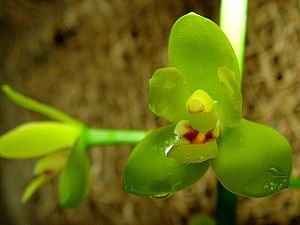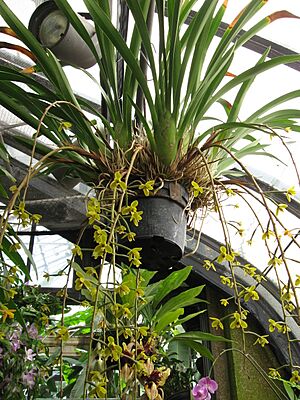Giant boat-lip orchid facts for kids
Quick facts for kids Giant boat-lip orchid |
|
|---|---|
 |
|
| Scientific classification | |
| Genus: |
Cymbidium
|
| Species: |
madidum
|
| Synonyms | |
|
|
The giant boat-lip orchid, known scientifically as Cymbidium madidum, is a beautiful plant from the orchid family. It grows naturally only in north-eastern Australia. This orchid often grows in clumps. It can be an epiphyte, meaning it grows on other plants (like trees) but doesn't harm them. It can also be a lithophyte, which means it grows on rocks.
Each plant has crowded, oval-shaped parts called pseudobulbs. From these, four to eight flat, strap-shaped leaves grow. The plant produces many olive-green flowers, sometimes up to seventy! The sepals and petals of these flowers curve forward, giving them a unique look. You can find this orchid in wet areas in eastern Queensland and north-eastern New South Wales.
Contents
What it Looks Like
The giant boat-lip orchid is a herb that grows in clumps. It has crowded, oval-shaped, slightly flattened green pseudobulbs. These pseudobulbs are usually about 12 to 25 centimeters (about 5 to 10 inches) long and 4 to 6 centimeters (about 1.5 to 2.5 inches) wide.
Each pseudobulb has between four and eight thin, strap-like, flexible leaves. These leaves can be quite long, from 30 to 90 centimeters (about 1 to 3 feet) long and 3 to 4 centimeters (about 1 to 1.5 inches) wide.
The plant produces a flowering stem that can be 20 to 60 centimeters (about 8 to 24 inches) long. On this stem, you'll find between ten and seventy olive green to brownish-green flowers. Each flower is about 22 to 35 millimeters (about 0.9 to 1.4 inches) long and 20 to 30 millimeters (about 0.8 to 1.2 inches) wide.
The sepals and petals of the flowers curve forward instead of spreading out wide. The sepals are about 12 to 15 millimeters long, and the petals are slightly shorter, about 10 to 13 millimeters long. The labellum (which is a special lip-like petal on an orchid) is about 12 to 15 millimeters long. It has three parts, called lobes. The side lobes stand upright, and the middle lobe is yellowish with a shiny ridge down its center. These orchids usually bloom between August and February.
Naming and Classification
The scientific name Cymbidium madidum was first officially described in 1840 by a person named John Lindley. He wrote about it in a publication called Edwards's Botanical Register.
The second part of the scientific name, madidum, is a Latin word. It means "moist," "soaked," or "sodden." This name likely refers to the moist places where this orchid loves to grow.
Where it Grows
The giant boat-lip orchid lives in rainforests and other wet areas. It often grows on trees that have bark which is fibrous or papery. You can also find it growing on rocks and cliffs. This orchid is found all the way from the Cape York Peninsula in Queensland, stretching south to the Hastings River in New South Wales.
Traditional Uses
In the past, both Australian Aboriginal people and early European settlers used the pseudobulbs of Cymbidium madidum. They used them as a traditional remedy for certain stomach illnesses.
See also
 In Spanish: Cymbidium madidum para niños
In Spanish: Cymbidium madidum para niños
Images for kids



